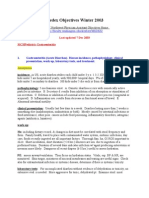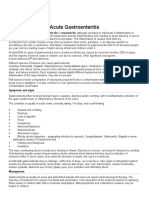Gastro Inter It Is
Gastro Inter It Is
Uploaded by
Dhea Imas WijayantiCopyright:
Available Formats
Gastro Inter It Is
Gastro Inter It Is
Uploaded by
Dhea Imas WijayantiOriginal Description:
Copyright
Available Formats
Share this document
Did you find this document useful?
Is this content inappropriate?
Copyright:
Available Formats
Gastro Inter It Is
Gastro Inter It Is
Uploaded by
Dhea Imas WijayantiCopyright:
Available Formats
GASTROINTERITIS
Gastrointeritis is an infection of the gastrointestinal tract, usually viral,
which present with a combinational of diarrhoea and vomiting (D&V).
Incidence an aetiology
In developed countries it is usually mild and self limiting (affecting 1 in 10
children under the age of 2 years) but in the developing world approximately 5
million children under 5 years old die from gastroenteritis each year.
Rotavirus is the most common pathogen in the UK but gastroenteritis cn
also be caused by :
-
Bacteria, including Shigellae, Salmonellae and Camplylobacter species
and Escherichia coli.
Three parasites: Entamoeba histolytica, Giardia lamblia and
Cryptosporidium species.
Clinical features
Viral infection can cause a prodmoral illness followed by vomiting and diarrhoea:
-
The vomiting might precede diarrhoea and is not usually stained with
bile or blood
Abdominal pain and blood or mucus in the stool suggest an invasive
bacterial pathogen.
The severity of diarrhoea can be underestimated if it pools in the large
bowel or if very watery stool is mistaken for urine in the nappy.
On examination, the most important physical sign relate to the presence and
severity of dehydration. The high surface area to bodyweight ratio in babies and
infants renders them susceptible to rapid derangement of fluid and electrolyte
balance.
Diagnosis
The differential diagnosis includes at least two important surgical conditions:
-
In young infants, especially boys (aged 2-12 weeks), vomiting might be
due to pyloric stenosis. Stool output is reduced and visible peristalsis
with a palpable pyloric mass might be evident.
In older infants and toddlers (aged 1-2 years) intussusception present
with vomiting .
Paroxysmas abdominal pain and the eventual passage of redcurrant
jelly stools should raise suspicion of this condition, which is lethal if
over looked.
Investigations should include:
-
Measurement of the plasma urea and electrolytes if dehidrated.
Stool culture and microscopy.
Stool viral antigen detection.
Gastroenteritis, by definition, includes diarrhoea. It is important to look for other
causes when a child presents with vomiting alone.
Dehydrtion can be further classified according to whether the plasma sodium
concentration is normal, low (hyponatraemia) or high ( hypernatraemia). This has
a bearing on the fluids used for rehydration (see below).
Management
Rehydration
The key to management is rehydration with correction of the fluid and electrolyte
imbalance. The strategy depends on the severity of dehydration.
It is important to emphasize the importance of oral dehydration. Unless the child
has persistent vomiting, oral fluids is the best means for dehydration.
Smaller,more frequent sips may better tolerated and should be encouraged.
Disorders of the gastrointestinal system.
Mild dehydration
Oral dehydration solutions (ORS; e.g Dioralyte, Rehidrat) are used. These contain
dextrose to stimulate sodium and water reabsorption across the bowelwall.
Metode to severe dehydration
Oral dehydration is still indicated if tolerated. IV rehydration should be reserved
for those with vomiting or severse dehydration.
Early refeeding reduces duration of diarrhoeal illness caused by gastrointestinal.
IV therapy os over-used.
If there are signs of circulatory failure,immediate resuscitation is achieved
by intravenous admistration of 10-20 ml./kg of o.9 % NaCl (normal saline).
Further rehydration can usually be achieved satisfactorily with 5%
dextrose/0.45% saline with KCl added at a concentration of 20-40 mmol/L.
The volume required in24 hours is calculated from estimated deficit +
maintenance + ongoing losses:
DeficitDeficit = % dehydration + bodyweight in 1 kg (1 kg =1000 mL.
Maintenance Allow:
100 mL/kg/24 h for 0-10 kg bodyweight .
50 mL/kg/24 h for 20-40 kg bodyweight.
20 mL/kg/24 h for > 20 kg bodyweight.
Ongoing losses
Estimate the volume of vomit and diarrhoea. Calculate the volume required as
shown in the following axample of a child weighing 10 kg with estimated 10%
dehydration.
- Deficit = 10% of 0 kg = 1000 mL.
- Maintenance in 24 h = 100 mL/kg = 1000 mL.
- Total required in 24 h = 2000 mL.
1. Give Iv o.9% NaCl 20 mL/kg over 30 min = 200 mL.
2. Give1800 mL 4% dextrose/0.18% NaCl over 24 h, i.e. IV infusion at
75mL/h.
Medication
There is no role for antiemetic or antimedication in gastroenteris. ..........
You might also like
- Approach To A Patient With Diarrhea Dr. Mohamed Abu HmaidDocument61 pagesApproach To A Patient With Diarrhea Dr. Mohamed Abu Hmaidoss-20502745No ratings yet
- Module 1. Post-Test: Timeline of Historical BackgroundDocument5 pagesModule 1. Post-Test: Timeline of Historical BackgroundAna LuisaNo ratings yet
- Ad 9072 - Visa Cemea HQ Building Project Method Statement and Risk Assessment For Testing and Commissioning of Novec-1230 Fire Suppression SystemDocument15 pagesAd 9072 - Visa Cemea HQ Building Project Method Statement and Risk Assessment For Testing and Commissioning of Novec-1230 Fire Suppression SystemLABBU BHAINo ratings yet
- Treatment of DiarrheaDocument6 pagesTreatment of DiarrheaVictor TayoNo ratings yet
- Acute GastroenteritisDocument51 pagesAcute GastroenteritisuouoNo ratings yet
- Gastroenteritis:: Diarrhea & DehydrationDocument26 pagesGastroenteritis:: Diarrhea & DehydrationcorsaruNo ratings yet
- Diarrea CrónicaDocument6 pagesDiarrea CrónicaConsuelo RiveraNo ratings yet
- Diarrea Crónica UPTODATEDocument6 pagesDiarrea Crónica UPTODATEConsuelo RiveraNo ratings yet
- Meg Notes CR18-21Document14 pagesMeg Notes CR18-21KasraSrNo ratings yet
- Gastroenteritis: Presented by BSCN - Krchn. Paul Mutie Cyrus Pwani UniversityDocument35 pagesGastroenteritis: Presented by BSCN - Krchn. Paul Mutie Cyrus Pwani UniversityAleeya rizviNo ratings yet
- Diarrhea 1Document5 pagesDiarrhea 1Mohammed Taha Al-nuaimyNo ratings yet
- Acute Gastroenteritis in Infants and Children: Undate ArticleDocument6 pagesAcute Gastroenteritis in Infants and Children: Undate ArticlechibieNo ratings yet
- Diarrhea CaseDocument8 pagesDiarrhea CaseStarr NewmanNo ratings yet
- Acute GastroenteritisDocument23 pagesAcute GastroenteritisSandhya BasnetNo ratings yet
- DIAREDocument20 pagesDIARESetiyo JuniantoNo ratings yet
- Osmotic Diarrhoea: Difficile)Document4 pagesOsmotic Diarrhoea: Difficile)Marwan M.No ratings yet
- Practice Essentials: Clinical PresentationDocument3 pagesPractice Essentials: Clinical PresentationtesaNo ratings yet
- Diarrhea GuidelineDocument29 pagesDiarrhea GuidelineMonica GabrielNo ratings yet
- DIARRHEADocument44 pagesDIARRHEAKristin Masehathena BerutuNo ratings yet
- Acute Gastroenteritis in ChildrenDocument38 pagesAcute Gastroenteritis in Childrencr07suiiNo ratings yet
- Diarrhea: Dr. Haifa Yagoub OsmanDocument23 pagesDiarrhea: Dr. Haifa Yagoub OsmanAlex SamNo ratings yet
- CHOLERADocument10 pagesCHOLERAFreda MorganNo ratings yet
- Dehydration PediatricDocument7 pagesDehydration PediatricNur HidayahNo ratings yet
- CholeraDocument21 pagesCholeraMASII100% (1)
- I V E C C S 2004: Luid TherapyDocument5 pagesI V E C C S 2004: Luid TherapyCaraiman RalucaNo ratings yet
- Cholera AssignmentDocument2 pagesCholera AssignmentARISNo ratings yet
- Gastroenteritis in Adults and Older Children: EpidemiologyDocument4 pagesGastroenteritis in Adults and Older Children: Epidemiologyjotq19No ratings yet
- Acute DiarrheaDocument2 pagesAcute DiarrheaDedy SumantriNo ratings yet
- Evaluation Chronic DiarrheaDocument34 pagesEvaluation Chronic DiarrheaarthoclaseNo ratings yet
- Chapter 45: Nursing Care of A Family When A Child Has A Gastrointestinal DisorderDocument14 pagesChapter 45: Nursing Care of A Family When A Child Has A Gastrointestinal DisorderAlyssaGrandeMontimor100% (3)
- 21.child With Diarrhea and Vomiting-SeminarDocument65 pages21.child With Diarrhea and Vomiting-SeminarRhomizal MazaliNo ratings yet
- GastroenterologyDocument17 pagesGastroenterologykhanNo ratings yet
- Age CPGDocument9 pagesAge CPGSLINo ratings yet
- Diare Noninfeksi.2017Document34 pagesDiare Noninfeksi.2017Tim IrmaNo ratings yet
- Chap 5 & 6Document6 pagesChap 5 & 6Claire AuditorNo ratings yet
- Acute Diarrhea 678Document24 pagesAcute Diarrhea 678Sheren GamaleldenNo ratings yet
- DehydrationDocument10 pagesDehydrationAbdelrahman M. AlnweiriNo ratings yet
- DiarrheaDocument6 pagesDiarrheakoreamydream85No ratings yet
- Diarrhea: Practice Essentials, Background, PathophysiologyDocument6 pagesDiarrhea: Practice Essentials, Background, PathophysiologyBilal El BariNo ratings yet
- Acute Watery Diarrhea (1399-05-22)Document31 pagesAcute Watery Diarrhea (1399-05-22)Shams Ul HaqNo ratings yet
- Klasifikasi Diare Pada AnakDocument15 pagesKlasifikasi Diare Pada AnakTia UtamiNo ratings yet
- Biochemical Aspect of DiarrheaDocument17 pagesBiochemical Aspect of DiarrheaLiz Espinosa0% (1)
- Gastrointestinal Tract Diarrhea Nausea Viral Infection BacteriaDocument60 pagesGastrointestinal Tract Diarrhea Nausea Viral Infection BacteriawakuyllibNo ratings yet
- Diarrhea Diarrhea: Signs and SymptomsDocument10 pagesDiarrhea Diarrhea: Signs and SymptomsMelhor TrioNo ratings yet
- Acute GastroenteritisDocument48 pagesAcute GastroenteritisAbel QuisquisNo ratings yet
- CholeraDocument29 pagesCholeraAhlam AliNo ratings yet
- Gastroenteritis CausesDocument6 pagesGastroenteritis CausesMikael AlmstrongNo ratings yet
- GastroenteritisDocument4 pagesGastroenteritisJulliza Joy PandiNo ratings yet
- Dayrit, Zandra Chris S.: What Is Pancreatitis?Document5 pagesDayrit, Zandra Chris S.: What Is Pancreatitis?Nicole Anne TungolNo ratings yet
- Case ManagementDocument11 pagesCase ManagementGabrielle CatalanNo ratings yet
- Chronic Diarrhea in Infants and ChildrenDocument45 pagesChronic Diarrhea in Infants and Childrenrawan.abujodahNo ratings yet
- Diarrhea in ChildrenDocument23 pagesDiarrhea in ChildrenSudeshna YadavNo ratings yet
- GI Bleeding PDFDocument9 pagesGI Bleeding PDFTia Amalia Puti RenaeryNo ratings yet
- Acute GastroenteritisDocument35 pagesAcute GastroenteritisAdil ShabbirNo ratings yet
- GastroenteritisDocument2 pagesGastroenteritisJoanna Marie M. dela CruzNo ratings yet
- Diseases With Diarrhea SyndromeDocument19 pagesDiseases With Diarrhea SyndromeManishNo ratings yet
- The Most Common Presenting Symptoms in CD Are Fatigue and Abdominal Pain While in UC Bloody BM and Diarrhea Are Most CommonDocument3 pagesThe Most Common Presenting Symptoms in CD Are Fatigue and Abdominal Pain While in UC Bloody BM and Diarrhea Are Most CommonElle ReyesNo ratings yet
- DIARRHOEADocument8 pagesDIARRHOEAJunaid AhmedNo ratings yet
- Peptic Ulcer Disease, A Simple Guide To The Condition, Diagnosis, Treatment And Related ConditionsFrom EverandPeptic Ulcer Disease, A Simple Guide To The Condition, Diagnosis, Treatment And Related ConditionsRating: 5 out of 5 stars5/5 (10)
- BakerPetitBrownPost AcceptanceTextDocument25 pagesBakerPetitBrownPost AcceptanceTextspamNo ratings yet
- Lesson For DemoDocument6 pagesLesson For DemoDebby BantugNo ratings yet
- Manual and Scoring Instructions For The Patient Health Questionnaire For Adolescents (Phq-A) Version 3.6.05 (March 6, 2005 Revised Edition)Document7 pagesManual and Scoring Instructions For The Patient Health Questionnaire For Adolescents (Phq-A) Version 3.6.05 (March 6, 2005 Revised Edition)GDTCjaNo ratings yet
- Spinal Manipulation-2016 - PDF RoomDocument10 pagesSpinal Manipulation-2016 - PDF RoomShreenath PujariNo ratings yet
- Book-Workplace Development PDFDocument391 pagesBook-Workplace Development PDFSara JordanNo ratings yet
- ChecklistDocument14 pagesChecklistYooleen SanchezNo ratings yet
- Bls (BHD) : Dr. Rusdian Nurmadi, Mked (An), SpanDocument74 pagesBls (BHD) : Dr. Rusdian Nurmadi, Mked (An), SpanDedi Iskandar4549No ratings yet
- Speaking Level Placement Test Business English British English StudentDocument2 pagesSpeaking Level Placement Test Business English British English StudentEsin ErdoğanNo ratings yet
- Region: Ilocos Region City: Dagupan City BarangayDocument6 pagesRegion: Ilocos Region City: Dagupan City BarangayMariah Karen Lorete EstreraNo ratings yet
- Feeding Beef Cows Based On Body Condition Scores: Division of AgricultureDocument11 pagesFeeding Beef Cows Based On Body Condition Scores: Division of AgricultureAbubakar Tahir RamayNo ratings yet
- Fractures Around The HandDocument16 pagesFractures Around The Handprajwal guptaNo ratings yet
- The Food Industry: History, Evolution and Current Trends: Department of Business and EconomicsDocument106 pagesThe Food Industry: History, Evolution and Current Trends: Department of Business and EconomicsJay ChenNo ratings yet
- Recovery CoachingDocument22 pagesRecovery Coachingapi-315973684100% (1)
- Recommendations For Managing Endodontic Emergencies During Coronavirus Disease 2019 OutbreakDocument8 pagesRecommendations For Managing Endodontic Emergencies During Coronavirus Disease 2019 Outbreakangel gudiyaNo ratings yet
- Avega Accredited Full Service ClinicsDocument7 pagesAvega Accredited Full Service ClinicsjhonnelkNo ratings yet
- Question I: Choose The Most Suitable Word or Phrase To Complete Each Sentence. (10 PTS)Document11 pagesQuestion I: Choose The Most Suitable Word or Phrase To Complete Each Sentence. (10 PTS)Huỳnh Minh ĐứcNo ratings yet
- Prevalence of A Gluten Free Diet and Improvement of ClinicalDocument9 pagesPrevalence of A Gluten Free Diet and Improvement of ClinicalNejc KovačNo ratings yet
- Reviewer in Personal DevelopmentDocument2 pagesReviewer in Personal DevelopmentAriane MortegaNo ratings yet
- The And: Hospital Anxiety Depression ScaleDocument10 pagesThe And: Hospital Anxiety Depression ScaleDiana MuñozNo ratings yet
- The Ultimate Supplement GuideDocument220 pagesThe Ultimate Supplement Guideryinlee008No ratings yet
- Sds - Ceasit SW VegDocument11 pagesSds - Ceasit SW VegebooktechnologieNo ratings yet
- BSAVA Manual of Canine and Feline Head, Neck and Thoracic SurgeryDocument250 pagesBSAVA Manual of Canine and Feline Head, Neck and Thoracic SurgeryAduviri Ordoñez100% (1)
- Skdi GehDocument30 pagesSkdi GehviandamayantiNo ratings yet
- Anatomy and Physiology of Adrenal GlandsDocument14 pagesAnatomy and Physiology of Adrenal GlandsEunice CuñadaNo ratings yet
- 2 People-v-Gilbert-de-La-PenaDocument6 pages2 People-v-Gilbert-de-La-PenaJomar TenezaNo ratings yet
- Gec 330 Test 1Document5 pagesGec 330 Test 1DonaldNo ratings yet
- Class IV Kennedy Removable Partial DentureDocument23 pagesClass IV Kennedy Removable Partial Denturemarwa100% (1)
- Activity Number-1 Sprouting Class:VI Subject:Science Duration - 2 DayDocument2 pagesActivity Number-1 Sprouting Class:VI Subject:Science Duration - 2 DayGayathriNo ratings yet

























































































